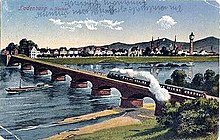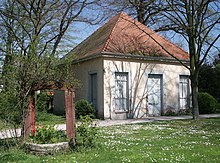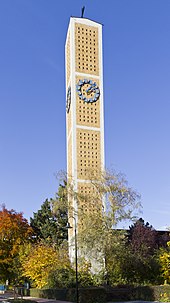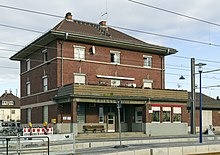Edingen-Neckarhausen
| coat of arms | Germany map | |
|---|---|---|
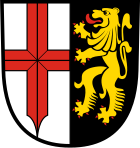
|
Coordinates: 49 ° 27 ' N , 8 ° 36' E |
|
| Basic data | ||
| State : | Baden-Württemberg | |
| Administrative region : | Karlsruhe | |
| County : | Rhein-Neckar district | |
| Height : | 103 m above sea level NHN | |
| Area : | 12.04 km 2 | |
| Residents: | 14,238 (Dec. 31, 2018) | |
| Population density : | 1183 inhabitants per km 2 | |
| Postal code : | 68535 | |
| Primaries : | 06203, 0621 | |
| License plate : | HD | |
| Community key : | 08 2 26 105 | |
| LOCODE : | DE EDI | |
| Community structure: | 2 districts | |
| Address of the municipal administration: |
Hauptstrasse 60–62 68535 Edingen-Neckarhausen |
|
| Website : | ||
| Mayor : | Simon Michler ( CDU ) | |
| Location of the community Edingen-Neckarhausen in the Rhein-Neckar district | ||
Edingen-Neckarhausen is a municipality with around 14,000 inhabitants in the Rhein-Neckar district in Baden-Württemberg . It is quite centrally located in the Rhine-Neckar metropolitan region .
geography
location
Edingen-Neckarhausen is located in the right central Upper Rhine Plain on the left bank of the Neckar , a little less than 8 km downstream and northwest of Heidelberg and about 12 km southeast and above Mannheim . There are two partial markings, that of Edingen and, further downstream, that of Neckarhausen.
Opposite Neckarhausen is the town of Ladenburg on the right side of the river on the north and north-east side of the municipality marker . In the east, just across the Neckar, borders Dossenheim with its hamlet Schwabenheim , and in the south-east, Heidelberg with its district Wieblingen . The western border of the municipality separates from the Mannheim district of Friedrichsfeld , with which the Neu-Edingen district of the municipality has grown together. Further to the north on the west side of the Mannheim district of Seckenheim lies a little further on. The municipality of Ilvesheim borders in the northwest , whose settlement area is again on the other side of the Neckar, but its district also includes an abandoned river loop on this side.
Edinger Ried
Two small community exclaves are located about 9 km southwest of the center of Edingen and south of Mannheim's Rheinau port on the Rhine near Brühl . These right bank strips, which together are less than 0.5 km² in size, and parts of the water at the mouth of the Leimbach and the Rhine are known as Edinger Ried . The southern exclave borders in the north on the Brühl district, which separates it from the north, in the east on the Schwetzingen district Schwetzinger Wiesen and in the south again on the Brühl district. The western border runs in the middle of the Rhine, beyond the Brühler district of the Koller Island in the southern section , and the Palatinate municipality of Otterstadt in the north . The much smaller northern exclave borders the Mannheim district in the north, the Brühl district in the south and the Altriper district in the west, again in the middle of the Rhine .
Community structure
The community of Edingen-Neckarhausen is divided into the two districts of Edingen and Neckarhausen. The districts are spatially identical to the earlier communities of the same name, their official name is in the form "Edingen-Neckarhausen, district ...".
The district of Edingen includes the district of Neu-Edingen and the Edinger Hof homestead. The Weierhof homestead belongs to the Neckarhausen district.
Neu-Edingen is geographically seamlessly connected to Mannheim-Friedrichsfeld . The city limits can only be found through the town signs in the middle of the village.
history
Edingen and Neckarhausen were settled as early as the Celts because of the mild climate and the good soil .

|
Edingen was first mentioned on November 17, 765 in a deed of donation over three yokes of land to the Lorsch Monastery , which was signed in Ladenburg. The lordship over Edingen lay with the imperial abbey Lorsch and the diocese of Worms . At the end of the 12th century , the count palatine took over the local and regional rule and exercised it until 1802. In the Electoral Palatinate, Edingen belonged to the Kirchheimer Zent , which was subordinate to the Heidelberg Oberamt . |

|
Shortly after Edingen was mentioned, Neckarhausen is also mentioned for the first time in the Lorsch Codex on June 26, 773. Between the end of the 14th century and 1705 , the bishopric of Worms and the Electoral Palatinate shared local and regional rule. Then the place came completely to the Electoral Palatinate and there, like Edingen, belonged to the Kirchheimer Zent and the Oberamt Heidelberg. |
When the electoral court moved from Mannheim to Munich in 1778, the secret state and conference minister Franz Albert Freiherr von Oberndorff (1720–1799) became governor of elector Karl Theodor in Mannheim. As part of his wages, he was raised to the rank of imperial count in 1790. Neckarhausen became the family seat of the young dynasty. The family estate is in front of the site.
The last man of his family, Alfred Graf von Oberndorff (1870–1963), was ambassador to Sofia and Warsaw and as a representative of the foreign office at the armistice negotiations in Compiègne in November 1918 . He is also buried in the local cemetery .
Edingen and Neckarhausen were burned down in the Palatinate War of Succession in 1689 . After the electoral Palatinate was dissolved, both places became Baden in 1803 . There Edingen belonged to the district office of Schwetzingen and Neckarhausen to the district office of Ladenburg , both of which later became part of the Mannheim district , later the Mannheim district .
During the Baden Revolution , Neckarhausen and the Neckar Bridge were a bastion of revolutionary troops against the Prussians in 1849 . As a supporter of the revolutionaries, the mayor of Neckarhausen was later sentenced to three months in prison.
Around 1900 - separated from the main town - the Neu-Edingen settlement was built at the Deutsche Steinzeugwarenfabrik in the immediate vicinity of the residential development in Friedrichsfeld.
From 1871 onwards, the National Liberals were politically strongest in Edingen before they were replaced by the Social Democrats in 1903 . During the Weimar Republic the left parties regularly had a majority, but due to their fragmentation, the center was the strongest party from 1924 onwards . From 1932 on, the NSDAP received the most votes and in 1933 it was 33 percent.
In Neckarhausen, the center, initially hidden by electoral alliances, was almost consistently the strongest party from 1871 to 1933, only briefly interrupted by the Social Democrats in 1919 and 1920.
After the Second World War , Edingen and Neckarhausen belonged to the American zone of occupation . The state of Baden was dissolved and the municipality became part of the newly formed federal state of Württemberg-Baden , which was added to the south-western state of Baden-Württemberg in 1952 . In the course of the Baden-Württemberg district reform, the Mannheim district was dissolved in 1973 and the two communities were incorporated into the newly formed Rhein-Neckar district . On May 3, 1975 they merged through the community reform to Edingen-Neckarhausen.
| Population development | 1439 | 1577 | 1777 | 1852 | 1905 | 1950 | 1961 |
|---|---|---|---|---|---|---|---|
| Edingen | 120 | 170 | 326 | 1042 | 2215 | 4262 | 5329 |
| Neckarhausen | 170 | 205 | 464 | 1032 | 1667 | 3217 | 4107 |
| New Edingen | 28 | 504 | 946 |
The following table shows the population development in the area of today's municipality Edingen-Neckarhausen.
| Population development | 1961 | 1970 | 1991 | 1995 | 2000 | 2005 | 2010 | 2015 |
|---|---|---|---|---|---|---|---|---|
| Residents | 10,382 | 13,026 | 14,161 | 13,834 | 13,843 | 13,905 | 14,379 | 13,959 |
Ice flood 1784
Towards the end of the extreme winter of 1783/1784 in the northern hemisphere , on February 27, 1784, Neckarhausen was largely destroyed and 13 people were killed. As a result of the thaw, huge ice masses had piled up on the Neckar near Wieblingen and drifted towards Ladenburg and Neckarhausen in the flood around noon. They carried destroyed ships and large wooden beams from the (old) Heidelberg Bridge , which had collapsed due to the ice drift . Buildings close to the banks were first brought down. Larger ice floes then caused further destruction. A total of 96 houses, 21 barns and 14 stables were torn away and 13 people drowned.
Religions
Elector Ottheinrich introduced the Reformation in 1556 . After seven changes of religion in the Electoral Palatinate, Catholics and Protestants were roughly equally strong in the two villages since the beginning of the 18th century , with a slight majority of Protestants in Edingen and Catholics in Neckarhausen. There has been a New Apostolic Church in Edingen since 1963 .
politics
Municipal council
The Edingen-Neckarhausen municipal council consists of 22 members who are directly elected every five years. The mayor is also the chairman of the municipal council.
The 2019 local elections led to the following result (in brackets: difference to 2014):
| Municipal Council 2019 | |||||
| Political party | percent | Seats | |||
| UBL ( FDP and FWV ) | 27.6% (+1.1) | 6 (± 0) | |||
| CDU | 24.3% (−6.2) | 5 (−2) | |||
| OGL ( Alliance 90 / The Greens ) | 23.6% (+6.3) | 5 (+1) | |||
| SPD | 16.9% (−8.8) | 4 (−1) | |||
| The left | 7.6 (+7.6) | 2 (+2) | |||
| Turnout: 65.8% (+ 10.1) | |||||
mayor
Due to the fact that the former mayors of Edingen-Neckarhausen each held their post for several terms, the dual community had only two mayors since the merger in 1975. Werner Herold (FDP) was the first mayor after the congregations were merged - in the absence of opposing candidates, he was officially supported by the FDP, CDU and SPD in 1975 and was able to record a historic election result of 98.31%. At this point in time Herold was already eight years as mayor of the Edingen district (elections: 1966 and 1973). Herold's tenure in the double congregation was 16 years. His successor was Roland Marsch (SPD) in 1991, and was confirmed in office in 1999 and 2007. For the mayoral election in 2015, Marsch declared that he would not run again. On November 8, 2015, Simon Michler (CDU) was elected as the new mayor in the second ballot with 42.92% of the vote. He took office on January 11, 2016.
coat of arms
The blazon of the coat of arms reads: In the shield split by silver and black, in front a continuous, polished red cross with a pointed foot, behind a red armored and red-tongued golden lion.
The municipal coat of arms was redesigned after Edingen and Neckarhausen were merged. The Lorsch Cross reminds of the historical relationship between the monastery and Edingen, while the Palatinate lion was already part of the original Neckarhausen coat of arms.
The flag is red and white and was awarded in 1977 together with the coat of arms by the Rhein-Neckar-Kreis district office.
Town twinning
We have had a partnership with Plouguerneau in Brittany ( France ) since 1967.
Neighborhood association
Edingen-Neckarhausen belongs to the Heidelberg-Mannheim neighborhood association , whose task it is to draw up the regional land use plan.
Culture and sights

Natural monument
- Bank on the Neckar
- Protected area "Edinger Ried" (located on the banks of the Rhine near Brühl)
Buildings
The classicist castle of the Counts of Oberndorff in Neckarhausen was built at the beginning of the 17th century as a post office for the Imperial Post Office , which was operated by the Thurn und Taxis . It has been expanded several times over the years. It has had its current appearance since it was added in 1910/11 on behalf of Count Friedrich von Oberndorff. The castle has been owned by the municipality since 1960 and is used as the town hall. To the west is the castle park in the English style.
The baroque church was built with substantial support from Count von Oberndorff and consecrated in 1783. It was presumably based on plans by Rabaliatti . The nave extends over four window axes. The retracted tower overlooks the gable facade with an attic by two storeys and is crowned with a characteristic onion dome. In 1960 the building was profaned and the patronage of St. Andrew was transferred to the newly built Catholic church directly behind it. The central building has a copper-clad dome made of steel and concrete above the chancel.
The Protestant Luther Church was built in 1934 as a simple building. In 1964 it was significantly expanded with a crossing tower and two side chapels with colorful glass walls.
In Edingen there is a classical Protestant church from 1793 with nine bells. Next door is the former brewery, which was converted into residential complexes in 1995 while retaining the original facade. The former palace garden opposite is now a public park.
The Catholic Church of St. Brother Klaus with the free-standing bell tower replaced the old St. Bartholomew's Church from the end of the 18th century, which had become too small and was therefore torn down.
Museums
Since 1995, exhibitions on changing topics related to Edingen-Neckarhausen have been shown in Neckarhausen Castle. The permanent exhibition "The Counts of Oberndorff" is open in the castle at certain times.
leisure
- Leisure pool in Neckarhausen
- Small indoor pool in the Pestalozzi School in Edingen
- Sports and leisure center (on Plouguerneau avenue)
- Sports hall Edingen with bowling alleys
- School sports grounds in Edingen
- Tennis courts in Edingen and Neckarhausen
- extensive sports facilities of the sports clubs Viktoria and DJK in Neckarhausen
- a dog sports club each in Edingen and Neckarhausen
- Boules facility in Neckarhausen
- St. Andreas Choir in Neckarhausen
- The Edingen trombone choir participates in church services and church festivals and gives its own concert once a year.
- The Musikvereinigung 1923 Neckarhausen eV was originally founded to accompany the children during the communion procession. It also gives an annual concert once a year and an Advent concert before Christmas.
Regular events
- the festival "Around the Castle" in Neckarhausen (once a year on the second weekend in July)
- the traditional everyone's tournament of FC Viktoria 1908 Neckarhausen (every Wednesday to Friday over Corpus Christi )
- the Neckarhäuser Kerwe (once a year on the first weekend in September)
- the Edinger Kerwe (once a year on the first weekend in October)
- Gockelfest (once a year on the third weekend in July)
- Fisherman Festival (once a year on the third weekend in August)
- the Neckarhausen Music Festival (annually in March)
Oddities
In the 1998 novel Tomboy by Thomas Meinecke , which is set in the Heidelberg university environment, the main character Vivian Atkinson lives in the old tobacco store in Edingen. The novel combines explanations of social science gender theories with local color from Heidelberg and the surrounding area. Individual passages of the novel take place in Edingen, and some local anecdotes are also told. Meinecke spent his youth in Edingen and is therefore very familiar with the local circumstances of the place.
Economy and Infrastructure
traffic
Road traffic
The community is located on the federal motorway 656 , which connects Mannheim and Heidelberg, as well as on the parallel L 637 (formerly B 37 ). The A 6 and the A 5 can be reached in a few minutes via the A 656 .
Rail transport
The public transport of the tariff area of the VRN belonging municipality is from the RNV on the route network of the Upper Rhine Railway operated (OEG).
Edingen (Baden) train station
The Edingen district is on the Mannheim Kurpfalzbrücke – Edingen – Heidelberg railway line and is accessible via the RNV (line 5) and a. connected with Mannheim and Heidelberg . Travel times from Edingen to the city center are around 30 or 20 minutes and to the main station around 35 or 10 minutes. In the Edingen district there is also an RNV train station and station building , which until a few years ago housed an interlocking , and a car hall next to it . The four-track OEG train station was refurbished between 2010 and 2011 and made barrier-free . The Edingen West stop , which is a little closer to the center of Edingen than the OEG train station, has also been converted to make it barrier-free and equipped with dynamic train destination displays .
DB station Neu-Edingen / Friedrichsfeld
The station building of the Neu-Edingen / Friedrichsfeld train station is located in the Neu-Edingen district , which is located in the area of Edingen-Neckarhausen, while all the tracks are already on the Mannheim district. In addition to Mannheim and Heidelberg via the Main-Neckar-Bahn , Darmstadt and Frankfurt am Main can be reached directly with regional trains (RE 60, RB 67, RB 68). In addition, a regional train runs every hour during the day via Mannheim Hbf , Ludwigshafen Hbf , Frankenthal Hbf and Worms Hbf to Mainz Hbf (RB 44). Due to its generously laid out platforms , especially between tracks 2 and 3, the station occasionally also functions as a long-distance traffic stop when route closures or diversions. During the realization of the second expansion stage of the Rhein-Neckar S-Bahn , it is to be connected to their network, for which the platforms were increased.
Other traffic
The Neckarhausen district is connected by bus routes with Edingen, Neu-Edingen, Seckenheim and Friedrichsfeld . A separate railway line also ran into the town center until 1969, but was then closed. Today the Main-Neckar-Bahn still crosses the district, but has no stop here. With the addition of the Main-Neckar-Bahn to the network of the RheinNeckar S-Bahn, a stop will be created in Neckarhausen .
With the city of Ladenburg on the other side of the Neckar, Neckarhausen is connected by a regular ferry and a railway bridge, which can also be used by cyclists and pedestrians .
media
The Mannheimer Morgen and the Rhein-Neckar-Zeitung report on local events in Edingen-Neckarhausen. The municipality's official bulletin appears weekly.
Offices
The administration is coordinated in the newly designed town hall in the Edingen district. In Neckarhausen Castle there is a branch office of the administration with a civil service and a registry office .
education
The Pestalozzi School in Edingen is a primary school and the Graf von Oberndorff School in Neckarhausen has also been a pure primary school since the Werkrealschule was discontinued in 2011. There is also the Edingen-Neckarhausen Adult Education Center and a branch of the Mannheim Music School. The community operates libraries in both districts . There are three Protestant and two Roman Catholic kindergartens for the youngest residents .
Personalities
Honorary citizen
- Werner Herold , former mayor
Sons and daughters of the church
- Edmund Bläss (1769–1844), Hessian politician, mayor in Viernheim and former member of the 2nd Chamber of the Estates of the Grand Duchy of Hesse
- Michael Koch (1853–1927), German painter
- Alfred von Oberndorff (1870–1963), diplomat
- Fritz Helmstädter (1904–1971), Member of the State Parliament (SPD)
- Eric Beißwenger (* 1972), German politician (CSU), MdL
Personalities who have worked on site
- Julius Helmstädter (1879–1945), Member of the State Parliament (SPD)
- Georg Kohler , old parish council, honorary ring holder of the municipality, holder of the Federal Cross of Merit and the Federal Cross of Merit 1st class
- Lieselotte Schweikert (1937–2020), politician (FDP), member of the state parliament, was awarded the badge of honor of the Baden-Württemberg municipal council
- Franz Mazura (1924–2020), chamber singer and actor, lived in the community from 1964 and received the badge of honor from his adopted home community Edingen-Neckarhausen in November 2014.
- Peter Wilhelm (* 1959), writer, born in Essen , has lived in Edingen-Neckarhausen since 1984
literature
- State Archive administration Baden-Württemberg in connection with d. Cities and districts Heidelberg u. Mannheim (Hrsg.): The city and districts Heidelberg and Mannheim: Official district description
- Vol. 1: General part . Karlsruhe 1966
- Vol. 3: The city of Mannheim and the municipalities of the Mannheim district . Karlsruhe 1970
- Hans Huth: The art monuments of the Mannheim district: Without the city of Schwetzingen . Munich 1967
- Paul Fütterer: Neckarhausen: past and present . Neckarhausen 1973
- Jochen Kahn: Edingen-Neckarhausen: Portrait of a new community . Edingen-Neckarhausen 1977
- Antje Gillich: "Freed from the ice ...". The old icebreaker from Edingen (Rhein-Neckar-Kreis). In: Preservation of monuments in Baden-Württemberg , 40th year 2011, issue 3, p. 166 f. ( online , PDF 138 KB)
- Rudolf Kreutzer: Ortssippenbuch Edingen-Neckarhausen 1647-1900 . Edingen-Neckarhausen: Friends of the Community Museum 2000 (= Badische Ortssippenbücher 89)
Individual evidence
- ↑ State Statistical Office Baden-Württemberg - Population by nationality and gender on December 31, 2018 (CSV file) ( help on this ).
- ↑ Main statute of the community Edingen-Neckarhausen from May 6, 1975, last amended on July 21, 2004
- ^ The state of Baden-Württemberg. Official description by district and municipality. Volume V: Karlsruhe District Kohlhammer, Stuttgart 1976, ISBN 3-17-002542-2 . Pp. 356-357
- ↑ Minst, Karl Josef [transl.]: Lorscher Codex (Volume 2), Certificate 673, November 17, 765 - Reg. 13. In: Heidelberg historical stocks - digital. Heidelberg University Library, p. 246 , accessed on February 2, 2016 .
- ↑ Minst, Karl Josef [trans.]: Lorscher Codex (Volume 2), Certificate 679, June 26, 773 - Reg. 909. In: Heidelberger historical stocks - digital. Heidelberg University Library, p. 249 , accessed on February 2, 2016 .
- ^ Federal Statistical Office (ed.): Historical municipality directory for the Federal Republic of Germany. Name, border and key number changes in municipalities, counties and administrative districts from May 27, 1970 to December 31, 1982 . W. Kohlhammer, Stuttgart / Mainz 1983, ISBN 3-17-003263-1 , p. 487 .
- ↑ District description, Vol. 3, pp. 464 and 707.
- ^ LUBW with oil painting by Ferdinand Kobell .
- ↑ Information platform Undine , Federal Institute for Hydrology, "The Ice Flood 1784".
- ↑ Deurer, EF: Complicated description of the great hardship affected by the ice drifts and floods in the cities of Heidelberg, Mannheim and other areas of the Palatinate in January and Hornung 1784: together with some previously mentioned natural attractions of the previous year. Neue Hof- und Akademische Buchhandlung, 1784, p. 139 ff . ( digital-sammlungen.de [accessed on March 25, 2019] Bayerische Staatsbibliothek digital).
- ↑ State Statistical Office Baden-Württemberg: Municipal elections 2019, Edingen-Neckarhausen ; Municipality of Edingen-Neckarhausen: Allocation of seats to the municipal council election 2019 (PDF) ; accessed May 30, 2019.
- ^ Herwig John, Gabriele Wüst: Wappenbuch Rhein-Neckar-Kreis . Ubstadt-Weiher 1996, ISBN 3-929366-27-4 , p. 51
- ↑ The S-Bahn is coming to Neckarhausen!
- ↑ Report in Mannheimer Morgen (accessed on March 2, 2015)
Web links
- Edingen-Neckarhausen community
- Edingen-Neckarhausen in the Burgenstrasse internet travel guide
- Neckarhausen Castle on a private website
- Icebreaker on the Edinger Neckarufer





